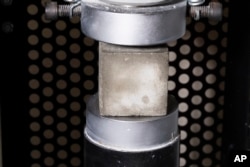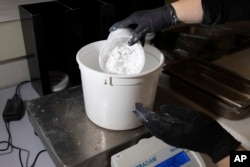An American cement maker has developed a technology that it says cuts levels of carbon dioxide (CO2) during production.
The International Energy Agency estimates the cement industry produces about eight percent of the world’s total CO2 emissions.
Cement is one of the main materials used to make concrete, the most widely used building material in the world. Cement makes up about 10 to 15 percent of concrete mixtures. Other materials include sand, small rocks, crushed stone and water.
Cement accounts for about 88 percent of concrete’s CO2 emissions. Under current methods, manufacturing one ton of cement produces nearly one ton of CO2.
Cement production involves heating the materials to very high temperatures in a device called a kiln. This part of the process releases CO2. The industry has yet to find an effective replacement for cement in concrete production.
The California-based cement maker Fortera says it has invented a new method that captures CO2 exhaust coming from the kilns as cement is made. The captured CO2 is turned into a solid substance and is later put back into the process to make more concrete.
Fortera’s chief executive, Ryan Gilliam, spoke to the Associated Press (AP) about his company’s efforts. He said the goal was to develop a less polluting cement production method “that can work really at any plant.”
In the beginning, Fortera said its method will reduce CO2 emissions by about 10 percent. The first reduced CO2 product will be produced at a Redding, California plant belonging to cement maker CalPortland. AP reports the product is expected to be available in the first week of May.
Fortera says its method is different compared to other low-CO2 cement products. That is because the company’s method could be widely built into existing plants.
Fortera’s effort is one of several in the industry that seeks to reduce the possible climate harm of concrete. In the United States, the American Institute of Architects is an industry group for builders. It educates many of the world’s top building companies about the dangers of CO2 in concrete.
Some governments, including Vancouver, British Columbia, have established building guidelines urging companies to produce lower-CO2 concrete.
California passed a law in 2021 that requires the state’s Air Resources Board to develop plans for the state’s cement industry to reduce its CO2 emissions. The targets seek cuts of 40 percent by 2035 and to reach net zero emissions by 2045. Net zero happens when a city or state removes at least as many emissions as they produce.
The First Movers Coalition is an international organization of more than 90 companies. The group seeks to help establish climate technologies to reduce CO2 emissions. The group announced new policies in 2021 aimed at creating greater demand for low-carbon cement through their market position.
The same year, 40 of the largest cement and concrete manufacturers agreed to use methods to make lower-CO2 concrete by 2050. Part of the agreement called for the development of new CO2-capturing methods.
Mike Ireland is the president and chief executive of the Portland Cement Association, the national trade group that represents U.S. cement manufacturers. He told the AP he thinks the U.S. “has to do what it can to be a leader to help other countries” with their cement-producing methods. “But we have to get the rest of the world, particularly the Global South, as they industrialize to leapfrog some of the technologies we have.”
Carbon emissions from cement manufacturing are “an existential threat to the world and for our industry,” he said.
I’m Bryan Lynn.
The Associated Press reported this story. Bryan Lynn adapted the report for VOA Learning English.
_________________________________________
Words in This Story
cement – n. a powder substance used in building that is mixed with water and sand to make a hard substance
emission – n. the act of sending something out such as a gas, heat, or light
concrete – n. a hard substance using in building operations
exhaust – n. gas waste produced by engines and industrial processes
architect – n. a person who designs buildings
leapfrog – v. to improve one’s position by going past other people quickly












Forum